|
| |
| YOU ARE IN: HISTORY
SCRAPBOOK |
|
Lots has happened in the past in Horsted Keynes and
courtesy of a number of correspondents and with the special assistance of
the Women's Institute, we present here a collection of pictures and
description of events in our history.
All pictures on this page are available for
full quality download. Click the picture then click "Save picture as".
Where available we have included a copy of the group photographs with the
names shown - Much of this information comes from 60 year old scraps of
paper and may well contain errors. If you see any please do contact the
webmasters. |
|
|
|
Her Majesty The
Queen makes surprise* visit to Horsted Keynes
Click here to see
Movietone film of the queen's visit to Horsted Keynes.
And just found - here is the
alternative Pathé coverage of the same event!
During the war, as a way to save petrol and film stock the
cinema newsreels co-operated with their coverage of minor events so as here
we have the same (or similar) footage with a different style
commentary. Movietone tended to be the more "formal plumb in mouth BBC"
whereas Pathé opted for a "Sky or ITN" style, often as here, bringing rather
more humour to the situation.
Depending on your
computer these old films may just play or you may need to play them
manually.
We have better quality versions in different formats if required.
November 8th 1939
|
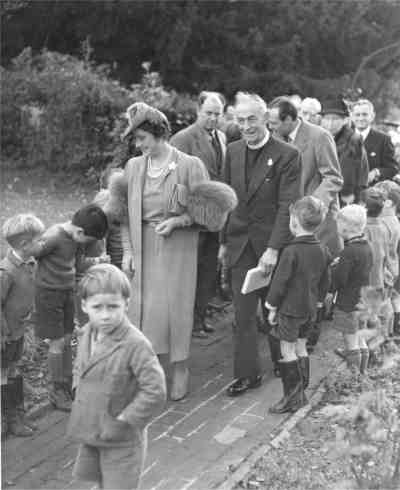 |
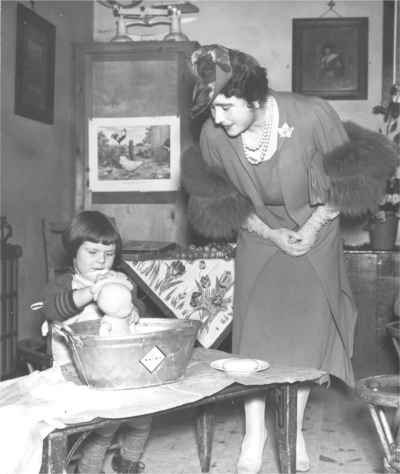 |
|
The Queen heads up the Church path towards the school.
Some bow, some look at the camera. |
In the village hall with "Shirley". |
|
|
|
|
Are you the little lad in front
of the picture above who is mentioned in the rather jovial Pathe commentary,
or are you in any of the other pictures? If so please get in touch with the
webmasters.
Were you evacuated to Horsted
Keynes? If so please do contact us - we may be able to reunite you with your
friends.
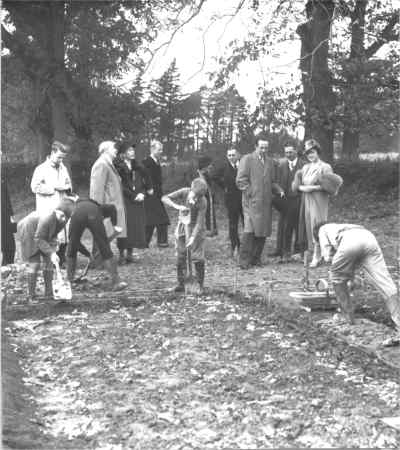
The Queen watches some of the Battersea boys "Dig For Victory" behind the
village hall.
(If you are young we will remind you that this was not
our present Queen but the late Queen Elizabeth the Queen Mother.)
|
M&S CATERING
FISH & CHIPS
The Green, Horsted Keynes.
EVERY TUESDAY 4.30pm - 7.15pm
CONTACT GARY SUDDS ON 01435 866501 |
* Judging by the number of cars parked
around the village and the number of people gathered near the village green,
as shown on the above films, the "surprise" visit can't have been that great
a secret!
|
|

The Queen yesterday paid a surprise* visit to
Horsted Keynes, a small Sussex village a few miles from Haywards Heath when
she saw evacuated children at work and play.
Her Majesty had asked to be shown
a typical reception area, and the authorities selected Horsted Keynes, where
there are 140 Battersea children with two head teachers and 10 teachers.
Plans for the visit had been kept from the children and the villagers.
The Queen was received by Lord De
La Warr, President of the Board of Education, and was taken first to the
village hall, which has been lent for use as a school for the smaller
evacuated children, aged three to seven. In the hall the Queen showed
particular interest in a group of little girls who were playing at
"mothers". Going up to a four year old girl named Shirley, who was bathing a
baby doll, the queen told her to not forget to wash behind its ears. "Oh
yes," replied Shirley, and began to scrub the ears.
Next the Queen went to the home
of Mr. I. Montiefiore who has placed a large hut in his grounds at the
disposal of the older evacuated boys. The Queen saw the boys doing physical
exercises, and later visited allotments where they were gardening.
At the village school which the
older evacuated boys are sharing with the local children during part of the
day, the Queen saw the boys having their midday meal, which is cooked and
served by voluntary workers. She expressed great interest in the needlework
of the girls, who are embroidering views of the village on canvas. The queen
also visited the Balham Nursery School, which has been evacuated to Birch
Grove House, Chelwood Gate, the residence of Lady Dorothy Macmillan.
The Daily Express of November 9th. 1939
led on the story the Hitler had escaped an explosion in a beer cellar but
also found room for our village. |
|
|
|
|
MORE ON THE BATTERSEA EVACUEES
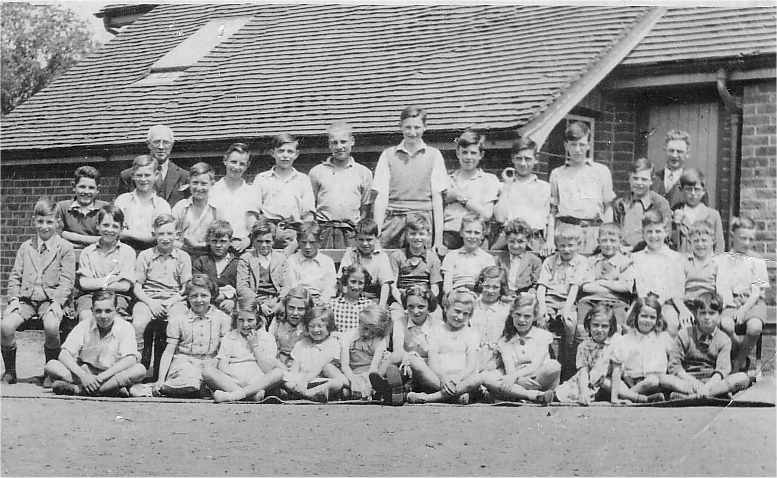
A newly found photo of the evacuees outside the village hall.
Courtesy of Ray Ward.
There is a larger picture showing more of the children further down
this page. |
|
I went to Horsted Keynes on the first of September
1939, as a evacuee from Battersea, I was seven years old, I went to live
with a Mr Mrs Pumprey in one of the cottages opposite the village
school. I stayed with them until my mother was injured in an air raid
and she came to the village to live we stayed at Hamsland cottage with
George and Margaret Alcorn.
I remember that we met the Queen Mother in the
village hall, that was our first classroom in the village I was writing
a letter home and the Queen read it.
There were lots of soldiers in the village and I
remember that one Christmas the American soldiers took us to there camp
for a Christmas party.
I have many happy memories of the time I lived in
the village and we often drive down and have walk to the church.
I hope this letter is of interest to you.
My name then was Lily Vine, it is now Easton.
|
|
Did you
ask for information?
We now have an overhead view of the old drill hall in Station
Road
click here
to see, but could still do with more firm information.
If you have first hand local knowledge then a
professional researcher has asked to hear from you.
Unfortunately since writing the above we
have tried to contact him as we have been offered some good
information but the email address we were given for contact is
redundant.
If you are the researcher who originally asked for our help
please email us as soon as possible.
Thanks. |
|
|
September 2008
I was one of the children evacuated to Horsted
Keynes in Sept 1939. My brother and I were billeted with Mr. & Mrs
Tidy at Trevor Cottage. As 69 years have passed since that time,I
decided to try and do some research, as I remember the visit by the
Queen. .I have visited your website and found a picture of us
digging for victory which I thought was taken in the grounds of
Mr.Montiefiore on who's grounds Mr Tidy worked as a gardener.
I was 12 years old when we went to Horsted
Keynes, and I have some good memories of my time there. After the
war when my brother got married he invited Mr & Mrs Tidy to the
wedding in London.
I suppose I could rack my brains for more
memories, but unfortunately I am getting a bit long in the tooth
now.
Ray Ward |
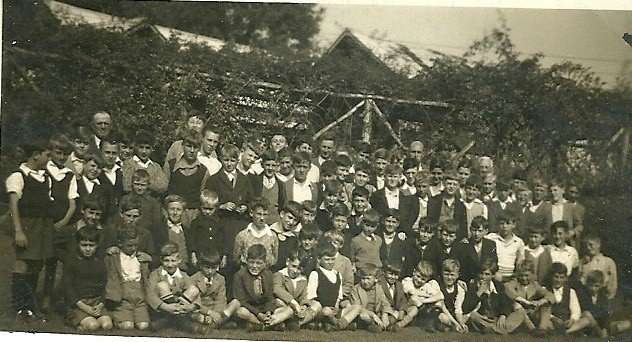
Better copy of the Battersea Boys Evacuated to Horsted Keynes in WWII
(Click the picture for larger size view)
Ray Ward sent an old
photo of the evacuees from Battersea. He says "From memory this was
taken I think at Valley Holme or could have been taken somewhere in the
village. I think this may be of some interest to you for your website."
It certainly is! As usual to see the detail just click the photo. Don't
forget you can make any photo appear larger to see more details by
clicking the bottom right of your browser window.Chris Anderson
has now supplied a better quality copy of the above picture if you would
care to look at it closer just click the picture. |
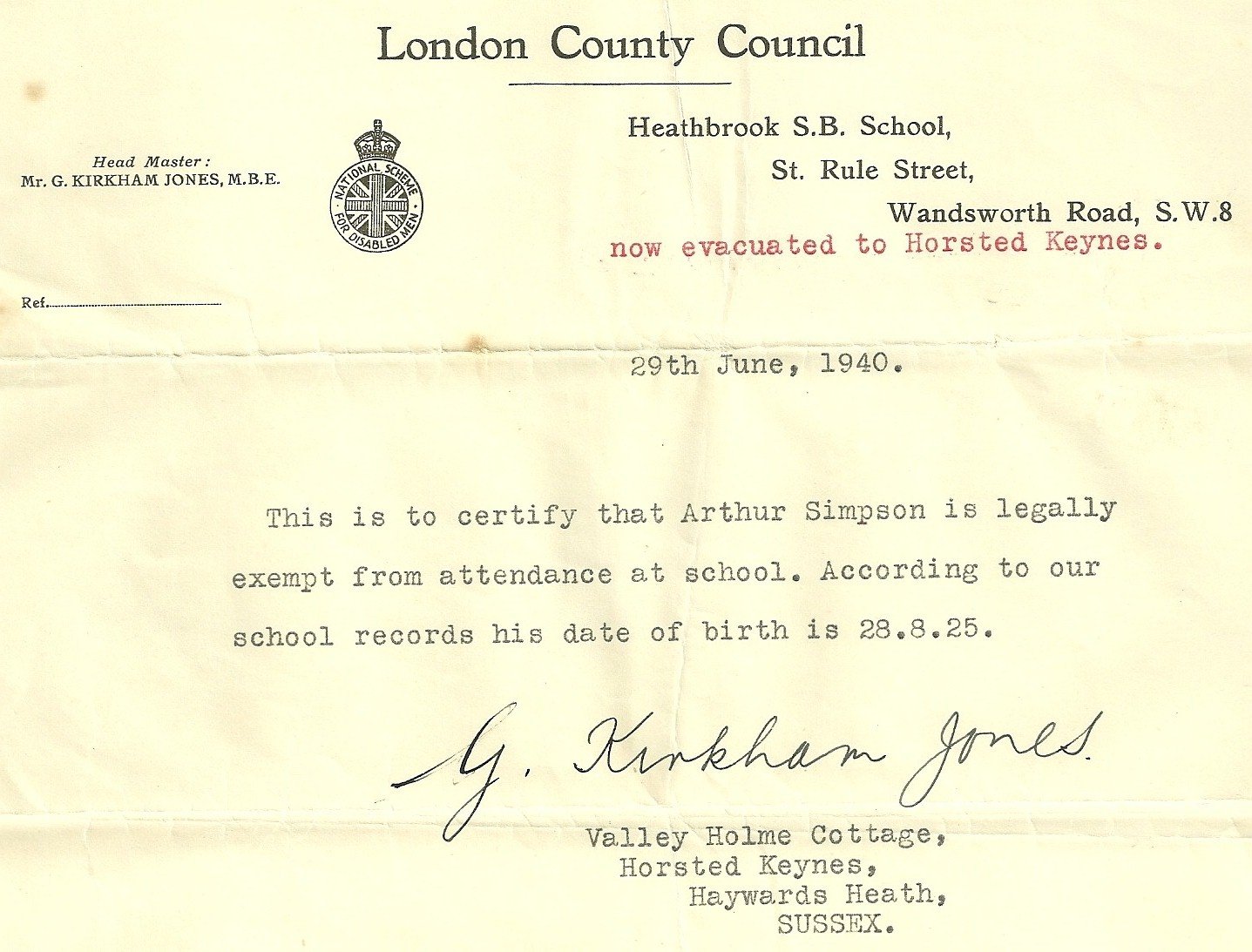
An interesting letter from the time and an address in
Valley Holme Cottage, Horsted Keynes. |
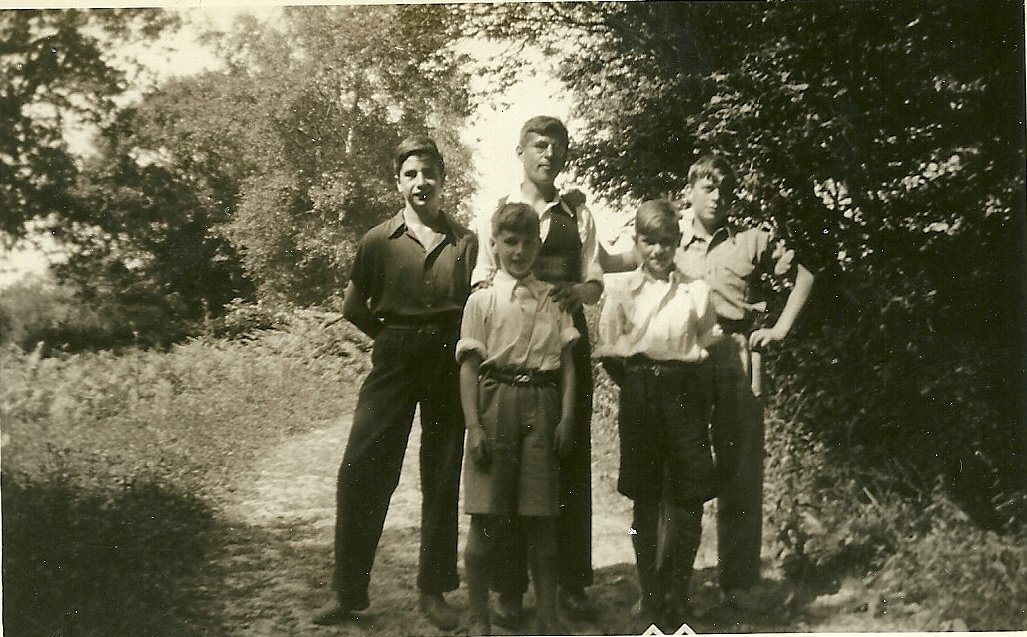
Another picture from Chris Andrews showing her father Arthur Simpson
(tall lad at the back) and some of the boys at Horsted Keynes. (Click
picture to see full size). Chris has other pictures from the era and can
be contacted at
andersonc8@sky.com |
|
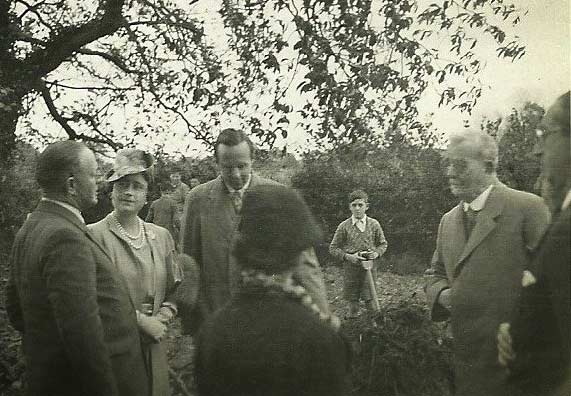
Another picture supplied by Chris Andrews showing
the queen in that November 1939 field. |
My name is Elsie Margaret Barley (nee Wisdom) and was
evacuated to Horsted Keynes on the 1st September 1939 and stayed there
for three and a half years. I would love to contact anyone who was there
at that time especially Roy Ward or Lily Vine.
I remember an Ivy Didcott and Kitty Sleeman. Kitty stayed at the Mc
Millan's house. Another name I recall was Ronald Roland whom I met at
the school at Haywards Heath. I had with me my three brothers Ron
Wisdom, Derek Wisdom who stayed at the Turner Stores who owned the Crown
pub opposite and my third brother Jeff who was billeted with me at
Council Cottages.
|
|
Text of the postcard on the right reads: 'Dear Mum I got your letter
today thank you for the comics. Dad sent me a letter today. I am going
to write to him. Well hope you are all write (his spelling was never too
good) Good by (next word I cannot make out at all) from your ever loving
son Arthur xxxx
| Another evacuee would like to correspond with his
old friends. Please contact Tom Simpson via dgeorge1979@hotmail.com
. Seems Tom was at the event when the Queen visited but can't see
himself in any of the pictures! |
|
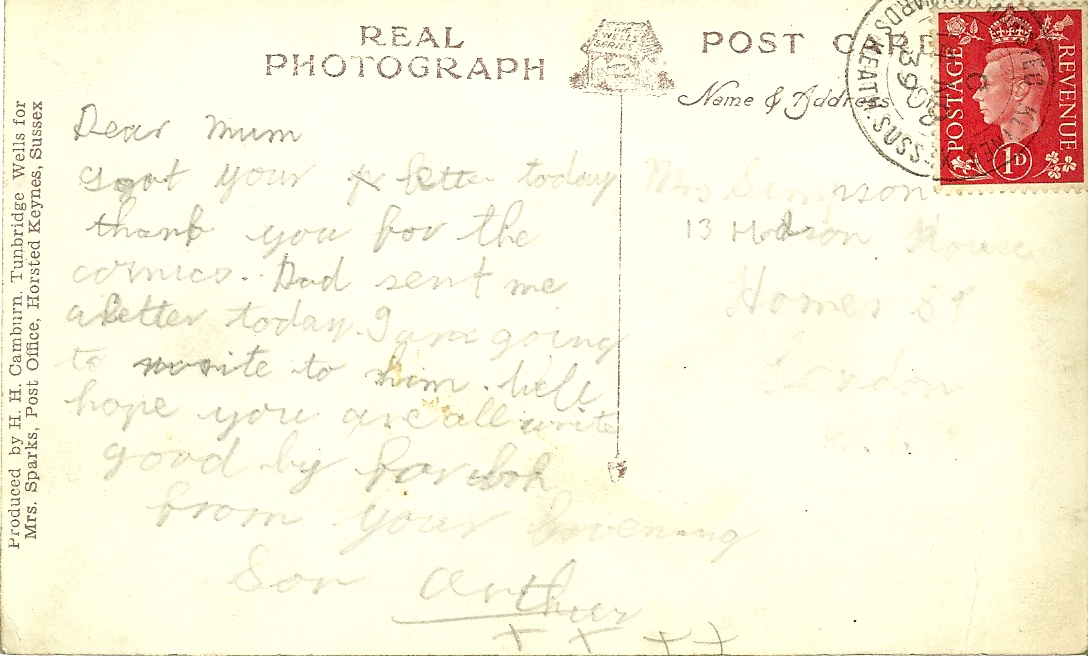
Postcard sent by a schoolboy from the village in 1939. The front picture
of the village in wartime is shown here. |
|
VE DAY in HK
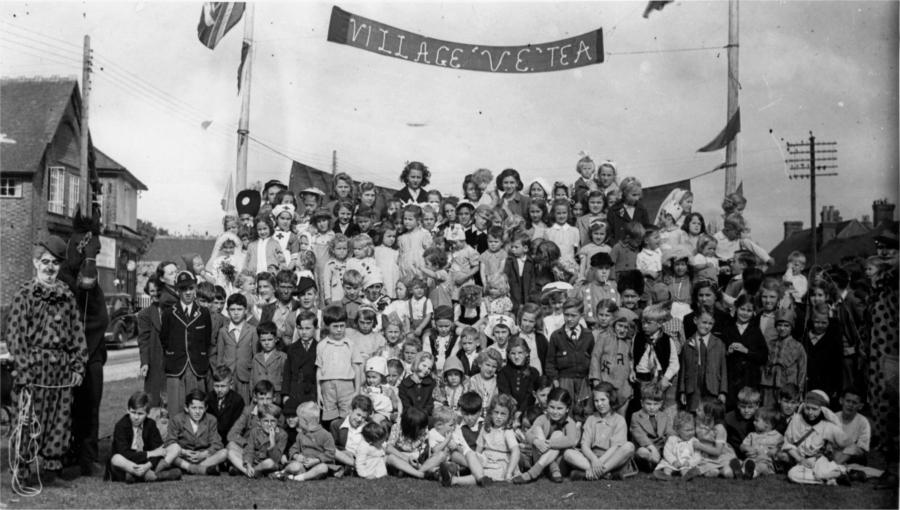
Thanks to Barry Franks we can show a picture of the village VE Day tea.
More details soon - Unfortunately we are having software problems at
present! |
|
Horsted Keynes Rectory in 1940
|
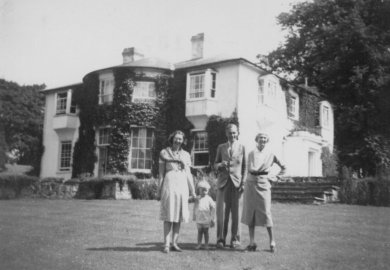
|
Here is a picture of Horsted Keynes Rectory in
1940. Now much extended and called The Old Rectory. Princess Diana
visited here by helicopter when looking for somewhere to live before her
marriage to Prince Charles. She was apparently advised that there were
security problems if she were to move there.
In the picture are (from left to right)
Mrs. Dora Christian Maycock, (née Sinker)
Dr. Christopher Hugh Maycock, b May 1937, now retired GP in Crediton,
Devon
The Revd. Herbert Guy Maycock, Rector of Coates in Gloucestershire, son
of Canon Maycock. Rector of Horsted Keynes from 1909 - 1915.
Mrs. Dora Blamire Sinker (née Young) widow of Provost John Sinker of
Blackburn Cathedral, mother of Dora Maycock |
With thanks to Christopher Maycock for the photo and
details of the people pictured.
|
|
Village War Years
The war years were busy and dark in Horsted Keynes
[It's not much lighter now!] as in other villages. we were a reception area
and soon we had Battersea school children and others in our homes (quiet a
number have stayed with us which says a lot for our village).
|
PUT THAT LIGHT OUT!
Like other communities Horsted Keynes had its own
ARP (Air Raid Precautions) Wardens. Their jobs were various but they are
perhaps best known for checking the blackout which was strictly imposed.
Miscreants who showed a light that might be useful to enemy bombers were fined or even imprisoned!
Perhaps a visit from the lady sitting on the right
hand end at the front was not so unwelcome! If you click on the picture of the man top
left you will see a larger view which shows that it has been doctored with the face superimposed on another body. Any
idea why this was done?
If you
are specially interested you can get a full quality copy by clicking the picture
to open it full size, then right click "save as". |

Click picture above for a full size copy, or click
HERE for a copy showing many of the
wardens names. We have recently amended the names in line with readers
recollections |
|
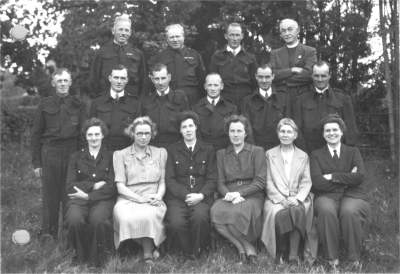
Click the picture for full size copy or
HERE for the group's names,
together with some extra notes by Nick Turner. |
FIRST AID GROUP
Now on the left we take a look at the war time
village "First Aid Group". We
are not sure of their duties, but if you are here we would welcome a
short article describing your typical day. No enemy aircraft were shot down in
the Parish during hostilities although neighbouring areas were not so fortunate
with several temporary airfield nearby. During 1944 we were on the edge
of "buzz bomb alley" with many V1 flying bombs flying overhead
heading towards London. These
sounded like an old car without a silencer as they used an Argus pulse engine
that oscillated at about 40 - 60 Hz. [You can see
an article and picture of its successor the aurora spy plane flying over
the village here]
|
|
AUXILIARY FIRE SERVICE
There was also an A.F.S. unit in the village led
by Mr. Lucas the local builder in Bonfire Lane who obtained a somewhat
vintage fire engine which distinguished itself by pumping for many hours
when Barcome Mills burnt down before the war.
He also built a fire station next to his yard to house it and together
with his green van carried the brigade to incendiary bombing fires etc.
In addition there were a number of housewives etc.
who were recruited and trained as Fire Watchers and who were supplied
with a rudimentary steel helmet and stirrup pump with which to tackle
the conflagration.
(If you have a photo of the A.F.S. members please get in
touch) |
|
A FAMILY V.E. CELEBRATION
Finally for now we see one village families celebrations
on May 8th 1945 which was V.E. (Victory in Europe) Day when for us
hostilities ceased.
The picture shows Mr. and Mrs. Joe Awcock and
friends celebrating the end of hostilities. We like the impromptu "Churchill
salute" on the left hand side! |
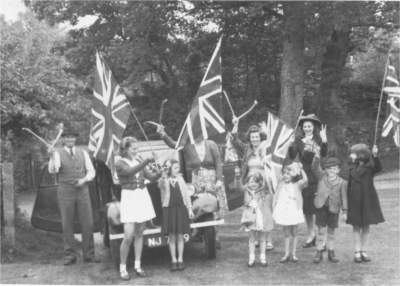 |
|
|
The Village and Sign at the end of the '50's |
|
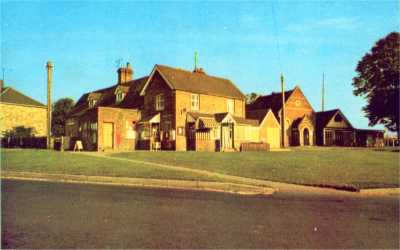 |
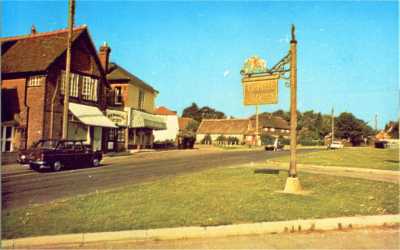 |
|
Now a couple of colour postcard views dating back
to the very late 1950's. Has the village changed much? The
butcher's shop isn't there and the church in the distance hasn't yet
been converted to a house.
The new village sign was erected shortly before the picture
was taken. Metalwork Reg Cook, Ardingly Blacksmiths, and Bob Fry.
Woodwork Harry Payne (Snr.). Masonry Tom Farmfield. Painting Bob Fry.
General Assistance Will Walden, Stan Turner.
The timber for the post and sign board was given by Busleys the timber
merchants. The sign was designed by Bob Fry but Peter Cook suggested and
carried out some improvements to the metalwork. |
|
|
Local characters - Mr. and Mrs.
Alfred Pelling
Picture of a villager with an interesting history. The caption, written
by Phyllis Aitkens,
speaks for itself and is presented as written. |
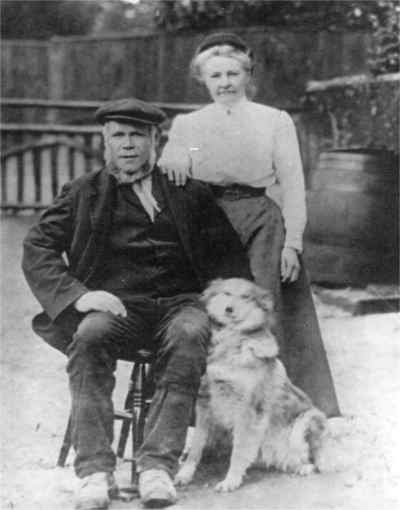 |
Alf was born in West Hoathly one of a large family
that nominally worked in the woods, but the menfolk were some of the
craftiest poachers in Sussex. Alf boasted in his old age to belonging to
one of the last gangs of “game runners” between the Weald and London. He
served several prison sentences – on one occasion he knocked a policeman
unconscious - put him in his own cart, and drove to Lewes jail!
He was the terror of the children going to school for he would roar like
a bull – But when he sat in ones garden with a pewter pot of draught
cider he was good company indeed, there was nothing he did not know
about the wild creatures of the woods.
The keepers couldn’t like him – he was too much like hard work for them
– but he had many friends and the village was the poorer for his
passing.
Mrs. Pelling was a gentle little lady, a wonderful cook, her cottage was
spotless and her home brewed wine was delicious.
Phyllis Aitkens.
|
|
Here direct from Horsted Keynes Women's Institute record
book we find Mrs. Pelling's 100 year old recipe for Dandelion Wine.
Written in Mrs. Pelling's own hand, we have tried to decipher the text
correctly, but cannot be responsible for the potency of the result!
Dandelion Wine
To make 9 gallons of wine:-
Boil 27 qts. of flowers in 9 gallons of water for
an hour.
Strain and boil again with 13lbs of best Demerara sugar,
10 hops, half a pond of brown ginger, orange and lemon peel to taste.
Slice 18 oranges (Seville) and 12 lemons, add to
sugar etc. and boil for 20 minutes.
Remove from fire and when blood warm add a little brewers yeast.
Strain again before putting into a barrel.
Allow to work 3 or 4 days before bunging tight.
Bottle in 6 months.
Mrs. Alfred Pelling |
|
|
Silver Jubilee
Day 1935
The village was certainly en-fate in 1935 to celebrate
the Silver Jubilee of King George V and his consort Queen Mary. Four
pictures from this time, which because of their quality we have not uploaded
in full quality. If you would like a copy please drop the webmasters a line
or give us a ring.
|
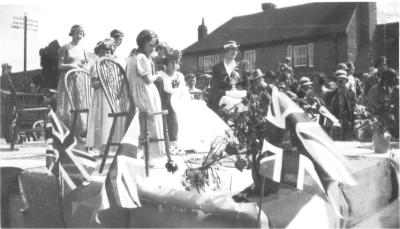
Above we see Nellie Tester being crowned May Queen by Lady Rachel
Egerton no less!
(Another photo from the day
here)
On the right the village green is put to use for
Maypole dancing. Isn't the Maypole still in the school? |
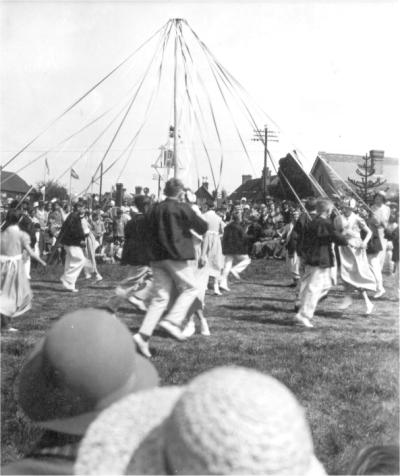 |
|
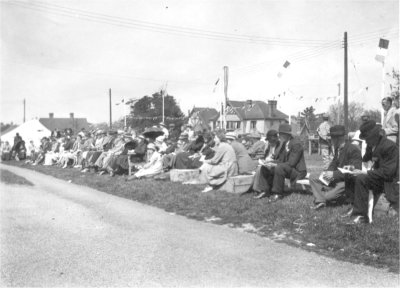
This picture is titled "Listening to the Broadcast" which leads one
to assume that radio had reached the village by 1935. It is easy to see
the three phase electricity poles! |
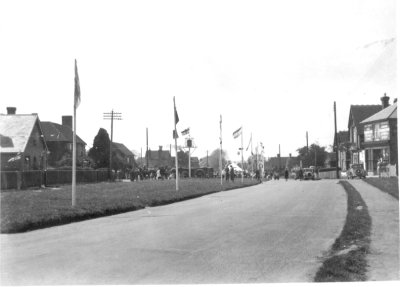
Finally a general view of the village green in 1935.
|
|
|
1933 - The
Broadhurst Beagles |
|
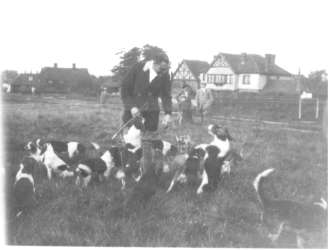 |
Hunted by Captain James Stobart for about 12 years. The
beagles gave much pleasure in the village and the young people went out
with them. Interesting to note that the electricity poles are
conspicuous by their absence, so power must have arrived in the two
years between 1933 and 1935! Apparently some of the village got electric
light before it got electric power. This might explain why some older
village homes still have sockets wired up to their lighting circuits -
dangerous! |
|
In the background is The Green Man Inn said to stand
on the site of an old workhouse. But certainly the village stocks stood
on the green in front of it.
The cottage that stands next to the inn is part of
the old building - as well as the back of the inn and the old fire
place. The pole in the far left carries telephone
wires. The "trunk" circuit ran from Haywards Heath to Uckfield through
the village there was a telephone amplifier hut at the top of the
village. We are still attached to the Uckfield exchange which is some 15
miles away! |
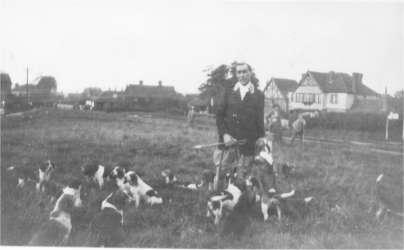 |
|
|
Some more Women's Institute Recipes
All are said to be "Real Sussex"
Punch - (As served at The Crown
Inn)
6 lumps of sugar,
Half lemon thinly sliced,
Quarter egg spoon nutmeg,
1 gill of shrub, [Orange, lemon, rum, sugar,
water]
1 gill brandy,
1 gill rum,
Boiling water to taste,
Sugar, lemon, nutmeg to be put into a warm bowl and
crushed with a little hot water (NOT wooden spoon).
Shrub, rum, brandy, mixed in jug -
Boiling kettle (of about 3 pints) -
Pour both together into bowl, letting the water
fall onto the spirits as they pour in.
Mrs. Reuben Baker
Pot Pourri
Rose Leaves, dark red and coppery pink (8 yellows)
Caruatious Clove
Sweet Peas - Hues for colours,
Lay leaves on flat surface, sprinkle a little Bay salt - leave for a day
or two keeping not stuck together.
Next sprinkle some Orris powder mixed with allspice powder.
When all is quite dry add bits of fine lemon peel
(dried),
lavender, vertua leaves, Bay leaves, sweet geranium, all dried and
broken.
Stick a Seville orange or tangerine with cloves and dry in a cool oven.
Then mix.
(Used by P. Aitkens – Strouds)
Angelica
Boil the stalks of Angelica in water till they are tender and then
put them in other warm water and cover them.
Let them stand over a gentle fire till they become very green, then lay
on a cloth to dry.
Take the weight in fair sugar with a little rose water, and boil it to a
candy height,
put in the stalks, and boil them up quick.
Then take them out and dry them for use.
John Nott 1723 – Cook to Duke of Bolton (Used by
Mrs. A. Gifoes)
Rosemary Tea
One pint of boiling water poured on one ounce of young tips – or sage
may be used.
For a sore throat or cough – Sage
Pour a pint of boiling water on a handful of sage leaves and when
moderately cool add a little vinegar and honey.
Take a teaspoonful at a time and also use as a gargle.
Mrs. A. Gifoes.
|
|
Mr. and Mrs. Hugh
Chalmers.
|
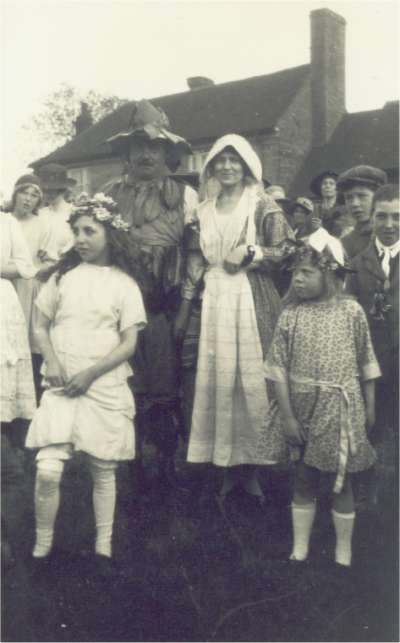
1922 - Mr. and Mrs. Chalmers "Jack in the Green"
Mrs. Chalmers trained local children in songs and dance. |
Came to live at Cheeleys,
Horsted Keynes,
after the first world war which was a most fortunate thing for Sussex
and for us. Mr. Chalmers became Hon. Secretary to the Sussex
Archaeological Society and did some wonderful work for them. In the
village he was elected Church Warden, at Miss. Marshall’s death, and for
the newly formed Horsted Keynes Women’s Institute he gave a lecture every year to a
packed hall on such divers subjects as “History Of Our Village”, “Six
Roads” and "Sussex in the Iron
Age”, etc.
With Mrs. Chalmers (the
daughter of Sir. Frank and Lady Benson) he brought new life again to the
village after the War Years with “May Day Revels and Drama”.
Mr. Chalmers died in 1928 and
then Mrs. Chalmers left the village often returning to entertain us or
speak at Women’s Institute meetings.
She is now Mrs. Richard
Kelly. |
|
|
"Land of Hope
and Glory" author's connection with Horsted Keynes
Mrs. Benson and Miss Tait
|
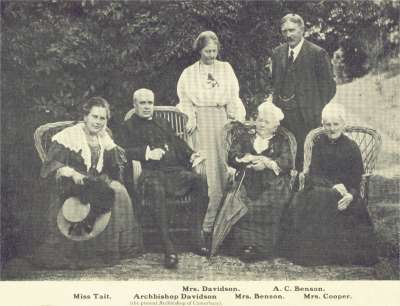
The above photo which was taken in the garden at Treemans in the
Summer of 1911, comes from a magazine article. |
|
Lived for some years at Treemans
[see later article]. Miss Benson was
the widow of Archbishop Benson a most loving and lovable person she had
a most beautiful sense of humour. Her bible study talks were a great joy
and help to the village.
Her sons A.C. (Who wrote "Land of Hope and Glory") E.F. and R.H. Benson mention the village and their old
house they all loved so much, in several of their books.
Miss Tait a daughter of Archbishop Tait and a life long friend of the
family lived with them until Mrs. Benson’s death in 1918 when she moved
to Ludwell which had just been enlarged and restored by Mrs. C.B.O. Clarke.
Archbishop and Mrs. Davidson were regular viitors both to Treemains and
Ludwell.
Beth Cooper, in the photo, is buried in St Giles Churchyard where there
is a memorial to her in the church. (The Benson Society made a trip to
Horsted Keynes several years ago and had tea at Treemans, and visited St
Giles and Beth's grave.) Beth was Mrs. Benson's nurse when she was a
child and stayed with her to become the beloved nurse to Mrs. Benson's 6
children. Three of the Benson sons became writers - most famous was E.F.
Benson, whose MAPP AND LUCIA series of novels is still in print.
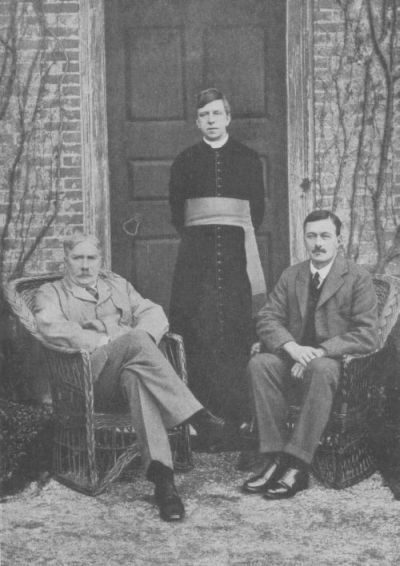
DECEMBER, 1913
A. C. Benson. Aged 51.
R. H. Benson. Aged 42.
E. F. Benson. Aged 46.
Photo by H. Abbott, Lindfield
From Project Gutenberg "Hugh" by Arthur Christopher Benson
http://www.gutenberg.org/files/18615/18615-h/18615-h.htm
Selected Poetry
http://rpo.library.utoronto.ca/poet/374.html
Land of Hope and Glory
Dear Land of Hope, thy hope is crowned.
God make thee mightier yet!
On Sov'reign brows, beloved, renowned,
Once more thy crown is set.
Thine equal laws, by Freedom gained,
Have ruled thee well and long;
By Freedom gained, by Truth maintained,
Thine Empire shall be strong.
Land of Hope and Glory,
Mother of the Free,
How shall we extol thee,
Who are born of thee?
Wider still and wider
Shall thy bounds be set;
God, who made thee mighty,
Make thee mightier yet
God, who made thee mighty,
Make thee mightier yet.
Thy fame is ancient as the days,
As Ocean large and wide
A pride that dares, and heeds not praise,
A stern and silent pride
Not that false joy that dreams content
With what our sires have won;
The blood a hero sire hath spent
Still nerves a hero son.
Arthur C Benson (1862 - 1925)
|
Click this line to hear Dame Clara Butt singing an
original version in 1911 (mp3 484Kb)
|
Note, from your webmasters. We
just love the different pace and phraseology of this version of "Land of
Hope and Glory". It quite simply makes sense of the words, where the version
sung at the "Last Night of the Proms" does not. Do please listen, and yes we
appreciate that the orchestra sounds like a group of musicians dragged in
after a long session in The Green Man, but still an historic recording now
well over 100 years old! |
|
Treemans
|
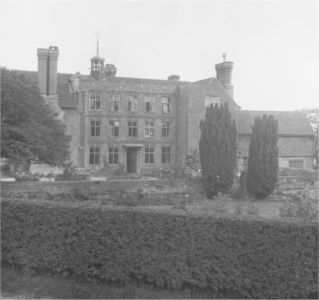 |
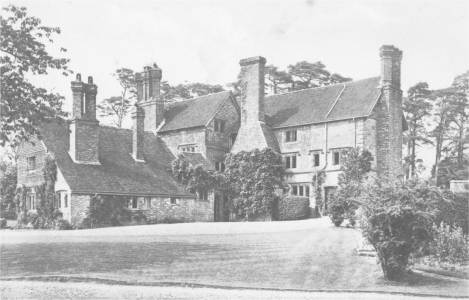 |
|
Looking West
Historic Treemans photographed in 1932
Looking South East
The house is now used by a large riding stables. |
|
The old 17th Century manor house of Treemans (pronounced
Trem-ans) lies to the South of Horsted Keynes with the avenue of ancient
Scotch firs, and was originally owned by the Wyatt family, infamous in
the days of Elizabeth 1st,
and famed for poetry and statesmanship.
The small wing of grey stone
was built by Thomas Wyatt, kinsman of the poet. The rest of the
brickwork was completed in the 17th century.
The interior is mostly
panelled in oak, partly Elizabethan and partly William and Mary, with
large open fireplaces backed with old Sussex ironwork. In one of the
chimneys a small
chamber still exists which is said to have been used as a
priest hiding place or "priest hole".
One large room is thought to
have formed the upper part of the original great hall with its ancient
beams and vaulted roof, presumably dated back to the 14th or
15th century. The whole property is described by A.C. Benson,
author of "Land of Hope and Glory", elder son of
Archbishop Benson whose widow lived at Treemans for many years, as “An
almost incredibly picturesque house”. |
|
|
Mr. and Mrs. Tidey married in 1926
| Mrs. Tidey was nurse in the Harmsworth family and Mr.
Tidey was gardener. The reception was given by Mr. and Mrs. V.
Harmsworth at Valley Holme, Horsted Keynes. This house features above in
the village of Her Majesty the Queen in 1939. Mr. Tidey acted as
sidesman in the church. They lived in a house opposite Lincoln Cottage.
It seems that most of the village were at the reception so a full
quality copy is available by clicking the picture. If you can identify
the guests please get in touch. |
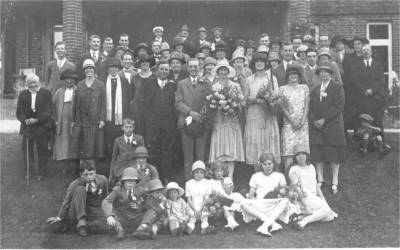 |
|
|
Newly Built - Boxes Lane Estate,
Horsted Keynes.
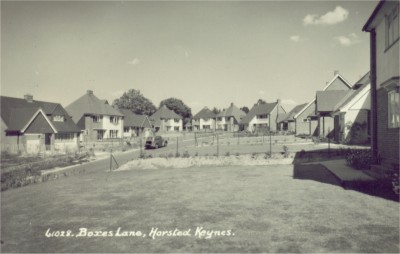 |
A most unusual subject for a postcard, but very
interesting to us is this view of newly built estate of houses in
Boxes Lane. We would guess the date as 1955, if you can be more
accurate please get in touch.In the past this area of land
was an orchard beside Boxes Farm with a hovel in the corner occupied
by a lady who bred donkeys. A road ran in from the left of this
picture leading directly from Ludwell to the village bakery in what
is now Lewes Road. Part of this road still exists at the back of the
gardens in Sugar Lane, and the rest continues as a public footpath.
In some places the old road has been buried under tons of garden
rubbish!
You can see how the village roads used to be in 1842
here. |
|
|
Even more updates
We have received a large amount of information about the
history of the village from former resident Bob Fry and will try to incorporate these additions as we update each page.
We ask readers to indulge us as the updates may take some time to
complete. |
|
We have many Megabytes of images waiting to
be coded and uploaded to the web site.
Most of the pictures have not been seen for many,
many years. Please look back!
 |
| |
|